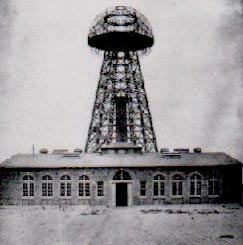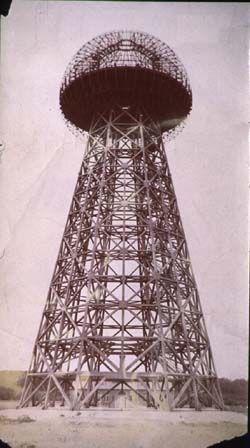Difference between revisions of "Tesla's Death Ray"
(fix typo) |
m (→Was the Tunguska Event Caused by Tesla's Death Ray?) |
||
| Line 33: | Line 33: | ||
The only response to Tesla's proposal was a form letter of appreciation from the president's secretary. The death ray was never reconstructed, and for that we should probably all be thankful. | The only response to Tesla's proposal was a form letter of appreciation from the president's secretary. The death ray was never reconstructed, and for that we should probably all be thankful. | ||
| − | Tesla made | + | Tesla made one further attempt to aid in his country's war effort. In 1917, he conceived of a sending station that would emit exploratory waves of energy, enabling its operators to determine the precise location of distant enemy craft. The War Department rejected Tesla's "exploring ray" as a laughing stock. |
A generation later, a new invention exactly like this helped the Allies win World War II. It was called radar. | A generation later, a new invention exactly like this helped the Allies win World War II. It was called radar. | ||
Latest revision as of 16:31, 7 December 2006
Was the Tunguska Event Caused by Tesla's Death Ray?
Given that Tesla's inventions generally possessed an element of social conscience, of doing good for humanity, it may seem surprising that he created a number of devices with military applications. And the notion of the Tesla harnessing his mind for purposes of war may seem immensely frightening. After all, this is the man who boasted that with his resonance generator he could split the earth in two... and no one was ever quite sure whether he was joking.The first Tesla invention with a proposed military use was his automaton technology, with which the labor of human beings could be performed by machines. Specifically, Tesla produced remote-controlled boats and submarines. He demonstrated the wireless ship at an exposition in Madison Square Garden in 1898. The automaton apparatus was so advanced, it used a form of voice recognition to respond to the verbal commands of Tesla and volunteers from the audience.
In public, Tesla spoke only of the humanitarian virtues of the invention: it would lessen the toils and drudgery of mankind and keep human lives out of harm's way. But Tesla actually had his hopes on a contract with the U.S. military. In a presentation before the War Department, Tesla argued that his unmanned torpedo craft could obliterate the Spanish Armada and end the war with Spain in an afternoon. The government never took Tesla up on his offer.Tesla then decided to pitch the automated submarine to private industry, and submitted it for the approval of J. P. Morgan. According to some accounts, Morgan offered to manufacture Tesla's vessels, but only if Tesla would agree to marry Morgan's daughter. Such a deal was of course anathema to Tesla, and he and Morgan would not work together until Wardenclyffe, a couple of years later.
Tesla eventually landed a successful military contract -- with the German Marine High Command. The product here was not unmanned sea craft, but sophisticated turbines which Admiral von Tirpitz used to great success in his fleet of warships. After J. P. Morgan cut off his support of Wardenclyffe, this foreign contract was Tesla's only substantial source of income. Upon the outbreak of World War I, Tesla chose to forfeit his German royalties, lest he be charged with treason.
Nearly broke, and finding the United States on the brink of war, Tesla dreamed up a new invention that might interest the military: the death ray.
The mechanism behind Tesla's death ray is not well understood. It was apparently some sort of particle accelerator. Tesla said it was an outgrowth of his magnifying transformer, which focused its energy output into a thin beam so concentrated it would not scatter, even over huge distances. He promoted the device as a purely defensive weapon, intended to knock down incoming attacks -- making the death ray the great-great grandfather of the Strategic Defense Initiative.
It is not certain if Tesla ever used the death ray, or indeed if he even succeeded in building one. But the following is the often-related story of what happened one night in 1908 when Tesla tested the foreboding weapon.
At the time, Robert Peary was making his second attempt to reach the North Pole. Cryptically, Tesla had notified the expedition that he would be trying to contact them somehow. They were to report to him the details of anything unusual they might witness on the open tundra. On the evening of June 30, accompanied by his associate George Scherff atop Wardenclyffe tower, Tesla aimed his death ray across the Atlantic towards the arctic, to a spot which he calculated was west of the Peary expedition.
Tesla switched on the device. At first, it was hard to tell if it was even working. Its extremity emitted a dim light that was barely visible. Then an owl flew from its perch on the tower's pinnacle, soaring into the path of the beam. The bird disintegrated instantly.
That concluded the test. Tesla watched the newspapers and sent telegrams to Peary in hopes of confirming the death ray's effectiveness. Nothing turned up. Tesla was ready to admit failure when news came of a strange event in Siberia.
On June 30, a massive explosion had devastated Tunguska, a remote area in the Siberian wilderness. Five hundred thousand square acres of land had been instantly destroyed. Equivalent to ten to fifteen megatons of TNT, the Tunguska incident is the most powerful explosion to have occurred in human history -- not even subsequent thermonuclear detonations have surpassed it. The explosion was audible from 620 miles away. Scientists believe it was caused by either a meteorite or a fragment of a comet, although no obvious impact site or mineral remnants of such an object were ever found.
Nikola Tesla had a different explanation. It was plain that his death ray had overshot its intended target and destroyed Tunguska. He was thankful beyond measure that the explosion had -- miraculously -- killed no one. Tesla dismantled the death ray at once, deeming it too dangerous to remain in existence.
Six years later, the onset of the First World War caused Tesla to reconsider. He wrote to President Wilson, revealing his secret death ray test. He offered to rebuild the weapon for the War Department, to be used purely as a deterrent. The mere threat of such destructive force, he claimed, would cause the warring nations to agree at once to establish lasting peace.
The only response to Tesla's proposal was a form letter of appreciation from the president's secretary. The death ray was never reconstructed, and for that we should probably all be thankful.
Tesla made one further attempt to aid in his country's war effort. In 1917, he conceived of a sending station that would emit exploratory waves of energy, enabling its operators to determine the precise location of distant enemy craft. The War Department rejected Tesla's "exploring ray" as a laughing stock.
A generation later, a new invention exactly like this helped the Allies win World War II. It was called radar.

